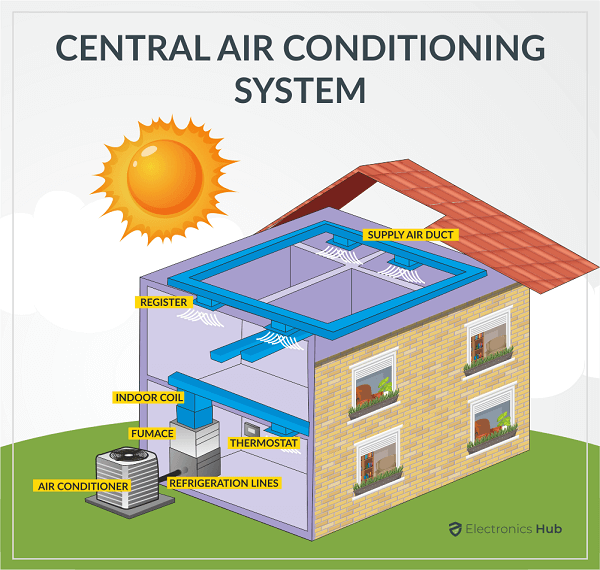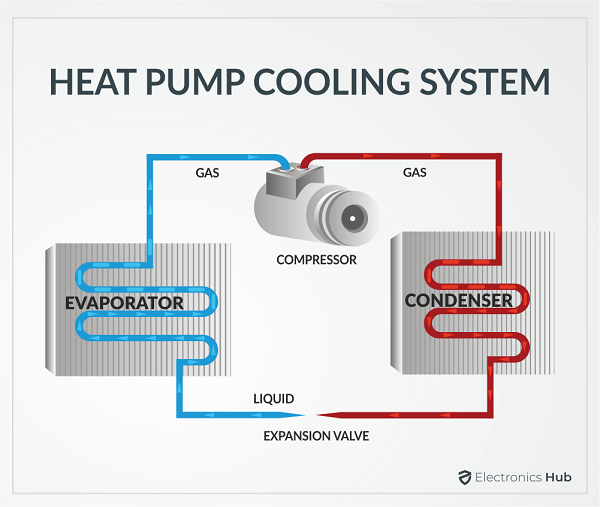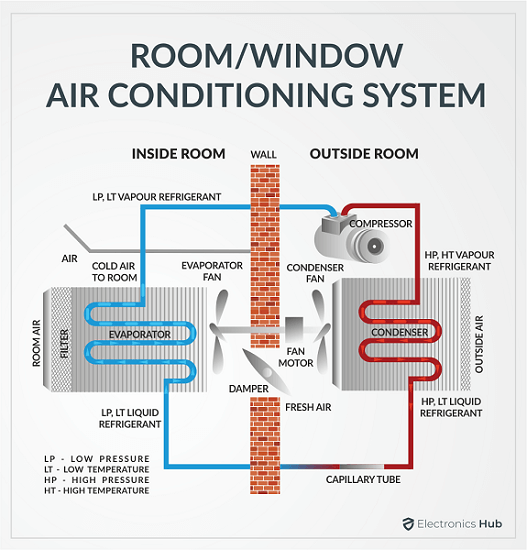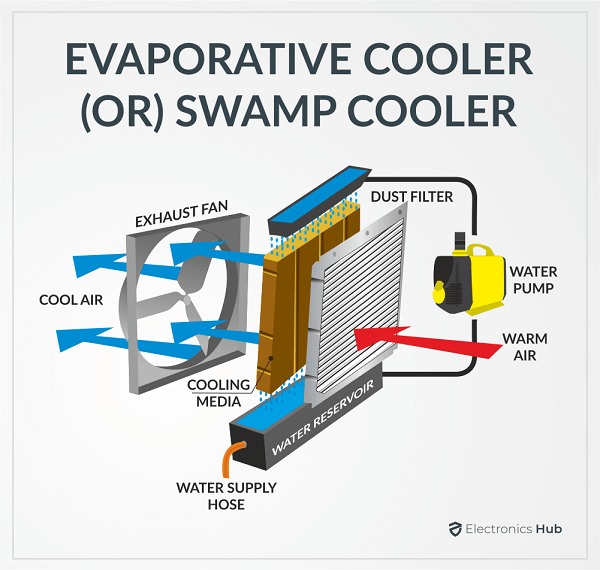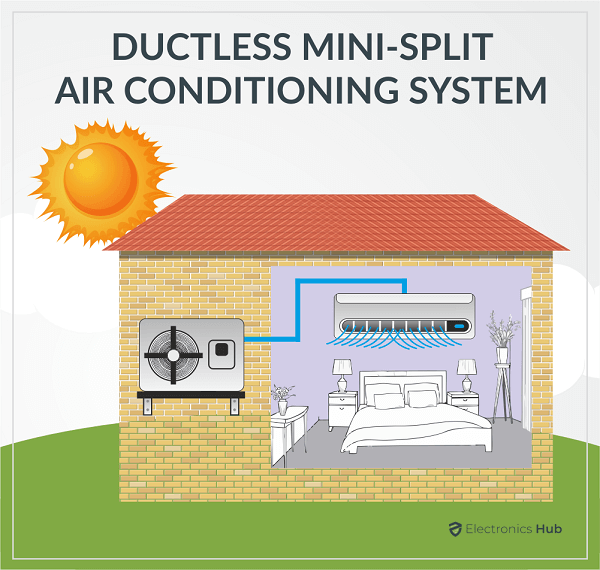A cooling system is a special apparatus used to maintain the temperature of a room or a whole structure. The whole system is made of different machines and apparatus to ensure even cooling is achieved through the structure of a building.
Air conditioning machines and home cooling systems are different. A complete home cooling system may be made up of multiple ACs to ensure the cooling and temperature condition is consistent.
Many modern homeowners now try to get better results while opting for air conditioning. They may need to switch to a home cooling system in such cases instead of relying on just air conditioners.
While air conditioners are a part of the cooling system, it requires more than switching on or off the AC machine in rooms.
Still confused? Here is a concise guide that will help you understand different types of cooling systems in detail. So, read on to know more-
Outline
ToggleTypes of Cooling Systems
1. Central Air Conditioning System
It is the most commonly used cooling system in buildings and apartments. This method is used to cool an entire building efficiently through a single or central unit. In most central air conditioning systems, the cool breeze is supplied in each room through ducts. The ducts are collected in the indoor and outdoor units.
The system comprises two units- the outdoor unit and the indoor unit.
The indoor unit comprises the evaporator coils, and the outdoor unit is made of compressor and condenser coils. The refrigerant lines link indoor and outdoor units to deploy cool air throughout the building effectively.
The outdoor unit channels the air into the indoor unit through the refrigerant link. The indoor unit then cheats conditioned air as per the desired level. This cool and conditioned air then travels through the ducts and cools each room.
Before installing the central air conditioning system, you need to consult a technician and electrician to find the desired model for your home cooling network.
In general, the technician calculates the expected load of your home to find the right size of cooling system you need. It is essential because undersized or oversized units cannot offer proper cooling or dehumidification.
2. Heat Pumps
The heat pumps are quite similar to the central cooling system. It is a heating system that offers heated air through ducts to keep rooms warm during winter and offers central cooling during the summer.
The heat pumps are also made of outdoor compressors and indoor coils like central cooling units.
During the winter, the heat pumps extract heat from the air. In some cases, geothermal heat pumps extract the heat from the ground. After that, the pumps distribute the heated air throughout the house to make the rooms warm and comfortable.
During summers, the system reverses. It extracts the heat from the rooms and throws the heat the outside, making the rooms cooler and more comfortable.
3. Room/Window Air Conditioning System
Room air conditioners are hassle-free and offer better customization. You need to install individual air condition units in each room to cool the rooms separately. It offers better customization as you can control the room temperature individually as per your preference. But, you may need multiple air condition units depending on the room numbers.
You need to install the machine in a part of the window or a special vent so that a part of the machine is outside of the room and another part remains inside.
The window ac machine first extracts the air and runs it through the refrigerating coil to make it cooler. The cool air then goes through the ac Duct that condenses and conditions the air and keeps the rooms cool.
You need to install the AC unit as per the room size. The room AC units come in sizes like 1-ton units, 1.5-ton units, etc. You can consult an HVAC technician to determine the right AC size.
4. Evaporative Coolers/ Swamp Cooler
Evaporating coolers or swamp coolers are not common but are a great option. These cooling systems consume less energy and electricity, making them a great investment in the long run.
If you live in hot and dry places, evaporative coolers or swamp coolers are better than central coolers or AC units.
The evaporative coolers have specially designed moist pads. The machines pull fresh air through these moist pads. The air gets cooled through evaporation during this stage. The cooler air is then circulated through the house or room.
The swamp coolers offer you a naturally cool breeze resembling the breeze you feel near a river or sea during the evenings. These machines can decrease the temperature by 30 degrees with proper installation.
On top of that, these coolers also add moisture inside the house, making the indoor ambient weather more comfortable for dry and hot places.
You can easily cut down the electricity cost by 70% if you use swamp coolers instead of the AC cooling systems.
Like AC units, evaporative coolers also come in different sizes and shapes. You can use portable coolers or wall-mounted swamp coolers as per your preference.
If you desire optimal cooling, you need to buy the right machine as per your room size.
In general, the capacity of a swamp cooler is measured as per the fan pressure needed to circulate the cool air through a certain area(in cubic ft.). Hence. Their power is described in the unit cfm. A 1500-square-foot room with 8-foot ceilings must have a 6000 cfm cooler to get the desired result.
5. Ductless Mini-Split Air Conditioning System
Ductless mini-split AC units are popular because they do not require any ducts for channeling the cooling air. The split AC units also come with outdoor and indoor split units. You need to install split indoor units in each room. The indoor units are connected to the outdoor unit through a conduit. This conduit supplies the power and also carries the refrigerant lines.
You can easily install the indoor split units on the wall or ceiling as you want.
The outdoor unit extracts air and cools it through the refrigerant lines. Then the indoor unit deploys the cooled and condensed air.
Since there are multiple individual indoor units, you can customize the temperature range in each room as per your choice.
These machines can cut down your electricity cost in the long run. But, since you need to install separate units for each room, the installation and purchasing cost is higher.
Conclusion
Overall, a cooling system is necessary for that much-needed comfortable breeze during the hot summer days. With different cooling systems available in the market, you need to become a sensible shopper. One must choose the right cooling system as per their budget, the climate of their living place, and their personal preference to enjoy some cool breeze.
Choosing the Right Cooling System for your Home
For getting a cooler breeze in your room during the scorching summer, you need to choose the best possible cooling system. Here is a concise guide for you-
-
The Climate
The climate is important when choosing the ideal cooling system for your home. If you belong to a place with hot and humid summers and extremely cold winters, you can choose a central cooling system, heat pumps, room AC or mini-split AC machines. These machines can control the humidity, ensuring you get the best comfort.
But, if you have a hot and dry summer, opt for swamp coolers. The swamp cooler air evaporative coolers can increase the humidity, making the temperature and indoor ambiance more comfortable.
-
Size
The size of the cooling unit also is important. If you buy a smaller or bigger machine, you may not get the desired result. Hence, before installation, consult a technician to get the best
recommendation.
-
Budget
Your budget is also important. Hence, consider different systems together to find the best possible cooling solution according to your budget.

